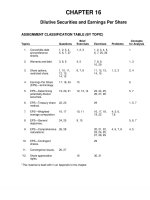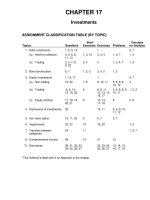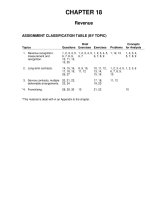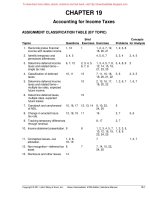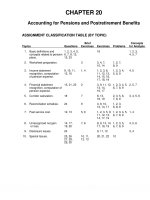Intermediate accounting IFRS 3rd ch13
Bạn đang xem bản rút gọn của tài liệu. Xem và tải ngay bản đầy đủ của tài liệu tại đây (1.44 MB, 98 trang )
Prepared by
Coby Harmon
University of California, Santa Barbara
13-1
Westmont College
CHAPTER 13
Current Liabilities,
Provisions, and Contingencies
LEARNING OBJECTIVES
After studying this chapter, you should be able to:
1.
Describe the nature, valuation, and reporting of current
3.
liabilities.
2.
Explain the accounting for different types of provisions.
Explain the accounting for loss and gain
contingencies.
4.
Indicate how to present and analyze liability-related
information.
13-2
PREVIEW OF CHAPTER 13
Intermediate Accounting
IFRS 3rd Edition
13-3
Kieso ● Weygandt ● Warfield
LEARNING OBJECTIVE 1
Current Liabilities
Describe the nature, valuation, and reporting of
current liabilities.
Three essential characteristics:
1.
Present obligation.
2.
Arises from past events.
3.
Results in an outflow of resources (cash, goods,
services).
13-4
LO 1
Current Liabilities
A current liability is reported if one of two conditions exists:
1.
Liability is expected to be settled within its normal operating cycle; or
2.
Liability is expected to be settled within 12 months after the reporting date.
The operating cycle is the period of time elapsing between the acquisition of goods and services and the final cash
realization resulting from sales and subsequent collections.
13-5
LO 1
Current Liabilities
Typical Current Liabilities:
13-6
1.
Accounts payable.
6.
Customer advances and deposits.
2.
Notes payable.
7.
Unearned revenues.
3.
Current maturities of long-term debt.
8.
Sales and value-added taxes payable.
4.
Short-term obligations expected to be refinanced.
9.
Income taxes payable.
5.
Dividends payable.
10.
Employee-related liabilities.
LO 1
Current Liabilities
Accounts Payable (trade accounts payable)
Balances owed to others for goods, supplies, or services purchased on open account.
Time lag between the receipt of services or acquisition of title to assets and the payment for them.
Terms of the sale (e.g., 2/10, n/30 or 1/10, E.O.M.) usually state period of extended credit,
commonly 30 to 60 days.
13-7
LO 1
Current Liabilities
Notes Payable
Written promises to pay a certain sum of money on a specified future date.
13-8
Arise from purchases, financing, or other transactions.
Notes classified as short-term or long-term.
Notes may be interest-bearing or zero-interest-bearing.
LO 1
Current Liabilities
Interest-Bearing Note Issued
Illustration: Castle Bank agrees to lend €100,000 on March 1, 2019, to Landscape Co. if Landscape signs a
€100,000, 6 percent, four-month note. Landscape records the cash received on March 1 as follows:
Cash 100,000
Notes Payable
13-9
100,000
LO 1
Interest-Bearing Note Issued
If Landscape prepares financial statements semiannually, it makes the following adjusting entry to
recognize interest expense and interest payable at June 30, 2019:
Interest calculation =
(€100,000 x 6% x 4/12) = €2,000
Interest Expense 2,000
Interest Payable
13-10
2,000
LO 1
Interest-Bearing Note Issued
At maturity (July 1, 2020), Landscape records payment of the note and accrued interest as follows.
Notes Payable
100,000
Interest Payable
2,000
Cash
13-11
102,000
LO 1
Current Liabilities
Zero-Interest-Bearing Note Issued
Illustration: On March 1, Landscape issues a €102,000, four-month, zero-interest-bearing note to Castle
Bank. The present value of the note is €100,000. Landscape records this transaction as follows.
Cash 100,000
Notes Payable
13-12
100,000
LO 1
Zero-Interest-Bearing Note Issued
If Landscape prepares financial statements semiannually, it makes the following adjusting entry to recognize
interest expense and the increase in the note payable of €2,000 at June 30.
Interest Expense 2,000
Notes Payable
2,000
At maturity (July 1), Landscape must pay the note, as follows.
Notes Payable
Cash
13-13
102,000
102,000
LO 1
Current Liabilities
E13-2: (Accounts and Notes Payable) The following are selected 2019 transactions of Darby Corporation.
Sept. 1 - Purchased inventory from Orion Company on account for $50,000. Darby records purchases gross
and uses a periodic inventory system.
Oct. 1 - Issued a $50,000, 12-month, 8% note to Orion in payment of account.
Oct. 1 - Borrowed $75,000 from the Shore Bank by signing a 12-month, zero-interest-bearing $81,000 note.
Prepare journal entries for the selected transactions.
13-14
LO 1
Current Liabilities
Sept. 1 - Purchased inventory from Orion Company on account for $50,000. Darby records purchases
gross and uses a periodic inventory system.
Sept. 1
Purchases
Accounts Payable
13-15
50,000
50,000
LO 1
Current Liabilities
Oct. 1 - Issued a $50,000, 12-month, 8% note to Orion in payment of account.
Oct. 1
Accounts Payable
50,000
Notes Payable
Interest calculation =
Dec. 31
($50,000 x 8% x 3/12) = $1,000
Interest Expense
Interest Payable
13-16
50,000
1,000
1,000
LO 1
Current Liabilities
Oct. 1 - Borrowed $75,000 from the Shore Bank by signing a 12-month, zero-interest-bearing $81,000 note.
Oct. 1
Cash
75,000
Notes Payable
Interest calculation =
Dec. 31
($6,000 x 3/12) = $1,500
Interest Expense
Notes Payable
13-17
75,000
1,500
1,500
LO 1
Current Liabilities
Current Maturities of Long-Term Debt
Portion of bonds, mortgage notes, and other long-term indebtedness that matures within the next fiscal
year.
Exclude long-term debts maturing currently if they are to be:
13-18
1.
Retired by assets accumulated for this purpose that properly have not been shown as current assets,
2.
Refinanced, or retired from the proceeds of a new long-term debt issue, or
3.
Converted into ordinary shares.
LO 1
Current Liabilities
Short-Term Obligations Expected to Be Refinanced
Exclude from current liabilities if both of the following conditions are met:
1.
Must intend to refinance the obligation on a long-term basis.
2.
Must have an unconditional right to defer settlement of the liability for at least 12 months after the
reporting date.
13-19
LO 1
Current Liabilities
E13-4 (Refinancing of Short-Term Debt): The CFO for Yong Corporation is discussing with the company’s chief
executive officer issues related to the company’s short-term obligations. Presently, both the current ratio and the
acid-test ratio for the company are quite low, and the chief executive officer is wondering if any of these short-term
obligations could be reclassified as long-term. The financial reporting date is December 31, 2018. Two short-term
obligations were discussed, and the following action was taken by the CFO.
Instructions: Indicate how these transactions should be reported at Dec. 31, 2018, on Yongs’ statement of
financial position.
13-20
LO 1
Current Liabilities
Short-Term Obligation A: Yong has a $50,000 short-term obligation due on March 1, 2019. The CFO discussed
with its lender whether the payment could be extended to March 1, 2021, provided Yong agrees to provide
additional collateral. An agreement is reached on February 1, 2019, to change the loan terms to extend the
obligation’s maturity to March 1, 2021. The financial statements are authorized for issuance on April 1, 2019.
Liability of $50,000
Refinance completed
Liability due for
Statement Issuance
payment
Dec. 31, 2018
13-21
Feb. 1, 2019
Mar. 1, 2019
Apr. 1, 2019
LO 1
Current Liabilities
Short-Term Obligation A: Yong has a $50,000 short-term obligation due on March 1, 2019. The CFO discussed
with its lender whether the payment could be extended to March 1, 2021, provided Yong agrees to provide
additional collateral. An agreement is reached on February 1, 2019, to change the loan terms to extend the
obligation’s maturity to March 1, 2021. The financial statements are authorized for issuance on April 1, 2019.
Current Liability of $50,000
Since the agreement was not in place as of the reporting date (December 31, 2019), the obligation
should be reported as a current liability.
Dec. 31, 2019
13-22
LO 1
Current Liabilities
Short-Term Obligation B: Yong also has another short-term obligation of $120,000 due on February 15, 2019. In
its discussion with the lender, the lender agrees to extend the maturity date to February 1, 2020. The agreement is
signed on December 18, 2018. The financial statements are authorized for issuance on March 31, 2019.
Refinance completed
Liability of $120,000
Liability due for
Statement Issuance
payment
Dec. 18, 2018
13-23
Dec. 31, 2018
Feb. 15, 2019
Mar. 31, 2019
LO 1
Current Liabilities
Short-Term Obligation B: Yong also has another short-term obligation of $120,000 due on February 15, 2019. In
its discussion with the lender, the lender agrees to extend the maturity date to February 1, 2020. The agreement is
signed on December 18, 2018. The financial statements are authorized for issuance on March 31, 2019.
Non-Current
Refinance completed
Liability of $120,000
Since the agreement was in place as of the reporting date (December
31, 2018), the obligation is reported as a non-current liability.
Dec. 18, 2018
13-24
Dec. 31, 2018
LO 1
Current Liabilities
Dividends Payable
Amount owed by a corporation to its stockholders as a result of board of directors’ authorization.
Generally paid within three months.
Undeclared dividends on cumulative preference shares are not recognized as a liability.
Dividends payable in the form of additional shares are not recognized as a liability.
►
13-25
Reported in equity.
LO 1





